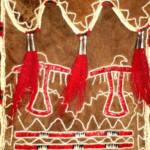Two materials were used to cover wigwams and longhouses in the Northeast: bark sheets and reed mats. During the historic period, canvas traded to the Native Peoples or taken from colonial and early American military encampments was also used, usually in conjunction with bark and mats. Animal hides were rarely used as a primary material in covering homes, such as it was for the tepee that took advantage of large hides provided by plains bison. Wigwams noted to use some hide coverings were usually the residences of communities located along the most northern and western borders of the Northeastern cultural area, and refugees – communities just uprooted, many times leaving behind their homes just burned in war. Hides and any sufficient materials were employed in making living quarters after the loss of their encampments and villages. Canvas, hides and other materials were also employed during times of confinement caused by the loss of land in treaties and forced migrations during Indian Removal. Although, canvas and other materials were utilized in poor times, bark sheets and reed mats were much more desirable; bark and reeds were the traditional materials utilized in home construction, valued for their effectiveness in making a comfortable indoor living space in inclement weather.
Bark was traditionally used to cover Northeastern Native American wigwams and longhouses. From spring to summer, many deciduous trees will yield their bark layer with little resistance. The reason lies with the annual growth of the tree, in which a new layer or ring is added to the sapwood just below the bark layers. Later in the year, the bark layer and sapwood will “fuse” together or become very hard to separate, making the window to harvest bark only when the new annual layer is being grown with substantial sap activity.
The historic Native Peoples perfected their method of bark harvesting by employing tools that cut into and wedged the bark off in a skillful manner that minimized the risk of splitting the bark sheets. Large, heavy barks were taken from trees while they were still standing, usually a job reserved for able-bodied men. One method was to use a ladder of sorts to climb as high as possible on the trunk to make the top cut high, making the resulting bark sheet in excess of 12ft tall. They used a special method of stripping the long piece of medium weight bark (not heavy), using the same ladder to support the bark as it was peeled. This method was especially necessary for medium weight bark used in making canoes, but not so much for house building. A 2007 bark canoe building project conducted by Erik Vosteen and Kevin Finney yielded a 16 foot long piece of elm bark weighing around 200 pounds. However, bark sheets were usually harvested in shorter sections, as tall as their axes would reach (5-6ft), or possibly a couple feet taller while standing on a small “step” (up to 8ft). The living tree being stripped of its bark cannot survive, which is why trees not coveted for their nuts or sap, or trees standing in areas where future cornfields had planned to be cleared were targeted. Presumably, trees uprooted by spring and summer storms were targets for their bark, as working from the ground level not only made it easier but allowed for the whole trunk to be peeled of its bark. These trees would have been stripped within days of coming down, as bark needs to be living, or within days of just dieing, to be separated and flattened.
Indeed, once bark was peeled, it was laid out flat on the ground so it might loose its natural cylindrical curve, or it was used right away, being secured to the house frame so it might take on the shape of the frame. When bark was secured on the home, usually an outside frame was constructed to compress the bark between it and the home frame. This is an important feature as medium to heavy barks can curl and warp with such force that cordage alone would not be sufficient to keep the bark flat..
Many trees yielded functional bark including poplar, ash, hickory, elm, and chestnut. Bark sheets were shingled on the home, bottom to top, to shed water. Today, there are a couple of companies that strip poplar bark, kiln dry the bark sheets flat, and sell them as home siding; it is said to be as good or better than conventional siding – a sort of nod to the ingenuity of the Native Peoples.
Another type of bark was utilized in the northern woods were natural birch trees grew to substantial sizes. Birch bark was much thinner and lighter in weight, allowing this type of bark to travel, a function other heavier barks did not offer. The sheets were sewn together to create long strips or “scrolls.” These bark scrolls could then be rolled, traveled with, unrolled with water and used to cover a temporary shelter. While heavier barks were placed on the homes by men, it was usually the place of women to arrange birch bark sheets on the wigwam.
While bark sheets worked well to shed water, it did not provide adequate insulation against cold weather. This was instead the job of reed mats. Woven interior mats were made to be hung on the inside of the wigwam or longhouse, such as many bulrush mats made carefully with decorative patterns woven in. These interior mats added air space and insulation between the outer bark wall and the interior living space. Women were the artisans of such works and were probably in charge of arranging the interior mats.
Other mats were made to be house coverings with or without the help of bark sheets. These exterior mats were usually made of spongy cattail leaves sewn together, each leaf side-to-side. These mats shed water: as an exterior mat was soaked by rain, the leaves of the mat expanded ever so slightly, creating a seal between each leaf, which then stopped the water from seeping through to lower layers of mats. Three to five layers of these mats made a wigwam a toasty warm place to live during the cold winter.
Cattail mats were also lightweight and able to role, making them the perfect house coverings to transport to temporary hunting, fishing, maple sugar, and wild rice camps. Women, who generally owned the home and most of the household goods, could carry several mats bundled on their backs. While their parcel may have been bulky, it was deceivingly lighter than it looked.
While mats were especially employed as home insulation against bitter winter weather, they were also employed by others, such as some coastal Virginia Native Peoples, for their ability to modify the home as the seasons changed. During the humid summer, the mats were rolled up on the sides of the home, transforming the house into an open-sided summer structure that invited cool breezes to pass through the living space, cooling down the residents.
For more articles on Northeastern Native American wigwams and longhouses, please refer to the author’s bio page with list of articles.



